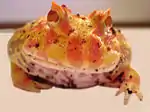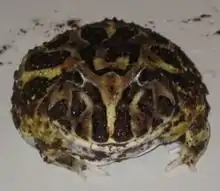Cranwell's horned frog
Cranwell's horned frog (Ceratophrys cranwelli), also called the Chacoan horned frog, is a terrestrial frog endemic to the dry Gran Chaco region of Argentina, Bolivia, Paraguay and Brazil. It, like other members of its genus, Ceratophrys, is commonly called the Pac-man frog, because of its resemblance to the video game character of the same name. Most adult specimens range from 8–13 cm (3.1–5.1 in) long and can weigh up to 0.5 kg (1.1 lb).

| Cranwell's horned frog | |
|---|---|
 | |
| Scientific classification | |
| Kingdom: | Animalia |
| Phylum: | Chordata |
| Class: | Amphibia |
| Order: | Anura |
| Family: | Ceratophryidae |
| Genus: | Ceratophrys |
| Species: | C. cranwelli |
| Binomial name | |
| Ceratophrys cranwelli Barrio, 1980 | |
The backs of these frogs typically have dark green and brown coloration, although albino variants with orange and yellow backs also exist. The dark color scheme aids in camouflaging the animal as it burrows and waits for its prey. Though generally inactive, they are aggressive eaters, and are capable of leaping for several body lengths to capture prey. They use their sticky tongue to latch onto prey and pull it into their mouth.
Cranwell's are nocturnal and rest with their eyelids open. They are ordinarily carnivorous, feeding mostly on insects and like-sized animals, and are known to cannibalize other frogs. Large individuals have bite forces comparable to those of mammalian predators.[1] Though they are capable of eating animals almost half their size, Cranwell's sometimes eat things larger than they are. However, due to a row a teeth along their upper jaw,[1] they are unable to release prey from their mouth causing them to potentially die by choking.[2]
At extreme temperatures, Cranwell's frogs enter a period of estivation, developing a thick layer of protective skin to trap moisture and aid in respiration. When estivation is complete, the frog uses its front and hind legs to help shed the protective layer. In many cases, the frog uses its jaws to help pull the skin over its back, often eating the skin in the process.
As pets
Like many Pacman frogs, Cranwell's are very popular as pets. As such, they should be kept in a humid environment such as an aquarium with moist substrate (not gravel). They should be fed a mixed diet of gut-loaded crickets, earthworms, small mice, and feeder fish. As a rule of thumb, these frogs should be fed every 1–2 days until the age of 18 months, at which point they should be fed once every 4–7 days.
Because of their large mouths, these frogs are particularly susceptible to impaction, a condition whereby the frog's gastrointestinal tract is obstructed by a foreign body accidentally swallowed. The foreign body can be almost anything, but in Pacman frogs kept as pets, it is commonly a small rock or piece of gravel used as substrate. Impaction often leads to constipation and malnutrition, and possibly death unless treated promptly with laxatives such as the osmotic diuretic lactulose. In severe cases, the volume of feces in the intestines is so large that the lungs are obstructed and the frog's breathing is impaired. Surgery is often the only alternative in these cases, although it is rarely performed because of its typically prohibitive costs.
References
- Lappin, A. K., Wilcox, S.C., Moriarty D. J., Stoeppler A. R., Evans, S. E., Jones, M.E.H. (2017). "Bite force in the horned frog (Ceratophrys cranwelli) with implications for extinct giant frogs". Scientific Reports. 7 (1): 11963. doi:10.1038/s41598-017-11968-6. PMC 5607344. PMID 28931936.CS1 maint: multiple names: authors list (link)
- WAZA. "Chacoan Horned Frog - Ceratophrys cranwelli : WAZA : World Association of Zoos and Aquariums". www.waza.org. Archived from the original on 2016-07-02. Retrieved 2018-11-10.
- Reichle; et al. (2004). "Ceratophrys cranwelli". IUCN Red List of Threatened Species. 2004: e.T56338A11464257. doi:10.2305/IUCN.UK.2004.RLTS.T56338A11464257.en. Database entry includes a range map and justification for why this species is of least concern

